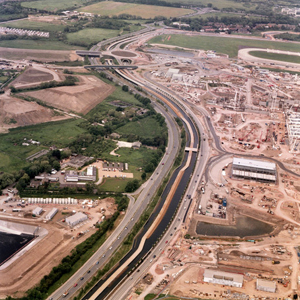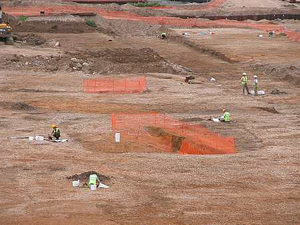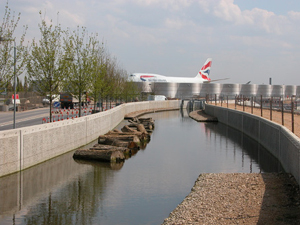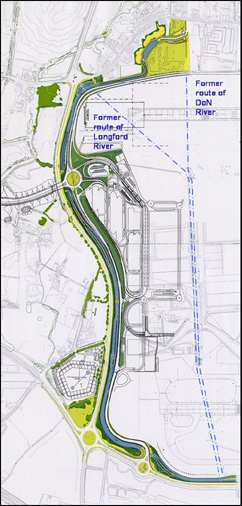The Twin Rivers Diversion Scheme |

92.7% |
Project Team: BAA, Laing O'Rourke Civil Engineering, Black & Veatch, KBR, Hyland Edgar Driver, TPS Consult
The project
 |
|
The £4.2 billion Terminal 5 (T5) Project at Heathrow airport is one of the largest construction sites in Europe. The project was approved by government in November 2001, after the longest public inquiry in British history. September 2002 saw the start of construction and the new Terminal is scheduled to open in 2008.
One of the most time-critical sub-projects of the T5 construction programme was the diversion of two rivers from their original alignment through the middle of the site. Construction on T5 could not progress until the Duke of Northumberland River and the Longford River were diverted around the western perimeter of the airport.
The Twin Rivers Diversion was a complex scheme, which involved not only the re-routing of two rivers but also the realignment of a live carriageway. The challenge was compounded by strict time constraints and the works' close proximity to local residents. Further restrictions to site activities resulted from the overhead flight path of the world's busiest international airport. However, the project team was committed to addressing the wide range of associated environmental issues. This commitment was underlined by applying for a CEEQUAL 'Whole Project Award' for the scheme.
Aspects that were of particular importance in the assessment were archaeology, waste management, ecology & biodiversity and landscaping.
Archaeology
 |
|
Before work commenced on each area, a comprehensive programme of archaeological investigations was undertaken across the entire T5 project. Construction was only permitted for each work area after hand-over from the dedicated archaeological team. A series of public exhibitions presented information on significant findings to the public.
Waste management
Waste arising on site was segregated where practical, and was then taken to the T5 waste facility where on average 85% of the material was recovered and recycled.
Ecology & biodiversity
 |
|
95% of the diverted rivers were placed in open channels, compared with only 50% for the original rivers. Pre-planted coir rolls and hazel hurdles provide habitat for small mammals along the naturalised banks. In-channel enhancements maximise the ecological value of the vertical-sided channels, creating a meandering flow pattern that further boosts river biodiversity. Relocated trees offer habitat for fish and invertebrates, and gravel enhancements create a medium for over 84,000 native river plants. A translocation programme for water voles, plants, fish, freshwater mussels and riverbed silts from the original rivers assisted regeneration of the aquatic environment within the new channels.
Landscaping
 |
|
A major programme of landscape enhancement was implemented within the western corridor of the airport by planting over 450 semi-mature trees, 2,000 semi-mature native shrubs and 100,000 evergreen groundcover shrubs.
To safeguard the future of the Twin Rivers Diversion scheme, the Twin Rivers Management Committee was formed as a bespoke management body responsible for the operation and maintenance of the diverted rivers.
The project scored 92.7% in the CEEQUAL 'Whole Project' assessment and was completed on budget and ahead of schedule. The key to the success of this project was the partnership between client, designer and contractor to create one integrated team.
 |
|
